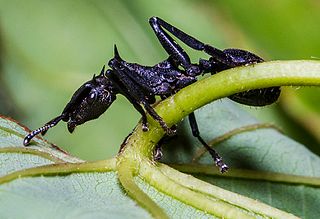
Myrmicinae is a subfamily of ants, with about 140 extant genera; their distribution is cosmopolitan. The pupae lack cocoons. Some species retain a functional sting. The petioles of Myrmicinae consist of two nodes. The nests are permanent and in soil, rotting wood, under stones, or in trees.

Cephalotes is a genus of tree-dwelling ant species from the Americas, commonly known as turtle ants. All appear to be gliding ants, with the ability to "parachute" and steer their fall so as to land back on the tree trunk rather than fall to the ground, which is often flooded.

Aphaenogaster is a genus of myrmicine ants. About 200 species have been described, including 18 fossil species. They occur worldwide except in South America south of Colombia, sub-Saharan Africa, and Antarctica.

Tetramorium is a genus of ants in the subfamily Myrmicinae that includes more than 520 species. These ants are also known as pavement ants.

Crematogastrini is a tribe of myrmicine ants with 64 genera and 8 fossil genera.

Anochetus is a genus of small, carnivorous ants found in the tropics and subtropics throughout the world.

Hypoponera is a genus of ants in the subfamily Ponerinae. The genus has a worldwide distribution and is found in all continents except Antarctica.

Trachymyrmex is a genus of fungus-growing ants in the subfamily Myrmicinae. The genus is mainly tropical in distribution, with most species being found in Central and South America.

Dolichoderus is a genus of ants found worldwide.

Stigmatomma is a genus of ants in the subfamily Amblyoponinae. The genus has a worldwide distribution, and like most other amblyoponines, Stigmatomma species are specialized predators. First described by Roger (1859), it was for a long time considered to be a synonym of Amblyopone until it was revived as an independent genus by Yoshimura & Fisher (2012) based on worker mandible morphology.

Technomyrmex is a genus of ants in the subfamily Dolichoderinae. With 98 species, it is one of the largest and most diverse ant genera in the Dolichoderinae. The genus distributed throughout the tropical and subtropical zones with most species occurring in the Oriental-Malesian and Afrotropical regions. One species, Technomyrmex albipes is a tramp ant now widespread throughout the tropics due to human activities.

Proceratium is a rare genus of ants in the subfamily Proceratiinae. It is the type genus of the tribe Proceratiini, which in addition to Proceratium consists of two even rarer genera: the extant Discothyrea and the fossil genus Bradoponera.

Discothyrea is a genus of small ants in the subfamily Proceratiinae. The genus is distributed in the tropics and subtropics throughout the world, where they usually nest in rotten wood, in the leaf litter, or under stones. Little is known about their biology, but ants in this genus are thought to be specialist predators of arthropod eggs and have been observed storing eggs in their nests.

Gnamptogenys is a genus of ants in the subfamily Ectatomminae. The genus has a wide distribution. It is known to occur in the Nearctic, Neotropic, Indomalayan and Australasian realms.

Octostruma is a genus of ants in the subfamily Myrmicinae. The genus is found in the Neotropics.

Cataulacus is a genus of ants in the subfamily Myrmicinae. The genus is distributed in the Paleotropical regions, mainly in the Afrotropics. Most species are found in forests, but a few are known from more open and arid habitats.
















